
25 years ago history was made for several different reasons. Today, as we reflect on the invasion, on the assassination, and on the massacres, we come across multiple news articles which provide information and commentary on the events of that year. I wanted to take the time to document and highlight these articles as they’re worthy reads in providing information to readers around the world. I encourage you to read these pieces – they are vital to our understanding and they will inform Sikhs and non-Sikhs alike about events in our history.
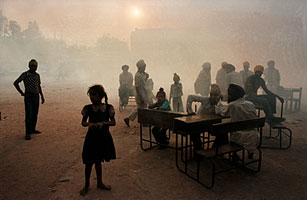 1. TIME magazine featured an article titled, “India’s 1984 Anti-Sikh Riots: Waiting for Justice.” Our readers have previously argued against the use of the word “riot” and suggested that “genocide” is the more fitting description of what happened. Regardless, this is an important article which discusses the often silent victims of 1984 – the widows and their children and the impact the events (and lack of justice) has had on their future.
1. TIME magazine featured an article titled, “India’s 1984 Anti-Sikh Riots: Waiting for Justice.” Our readers have previously argued against the use of the word “riot” and suggested that “genocide” is the more fitting description of what happened. Regardless, this is an important article which discusses the often silent victims of 1984 – the widows and their children and the impact the events (and lack of justice) has had on their future.
The widows’ colony in Tilak Vihar is a cheaply built and neglected cluster of homes, which were given by the government to hundreds of women and their children who survived what have become known as the anti-Sikh riots of 1984. But as the grim event’s 25th anniversary nears at the end of this month, crime, addiction and prostitution have taken root in what was supposed to be a survivors’ safe haven. Residents say this is because of the damage to the mental health of children who were witness to their parents’ and siblings’ murders and who grew up in impoverished homes and weren’t given any medical help — physical or mental — for their problems. [link]
Of note: for the 25th anniversary of the event, advertisements by Ensaaf — showing an old woman wiping away her tears, with the words, “25 years ago, our loved ones were burned alive in front of our eyes,” and in the next line, “Why has India, the world’s largest democracy, denied us justice?” — are scheduled for the month of November in the San Francisco Bay Area’s transit system!
Domestic violence organizations often use helplines to reach a larger population, while providing an anonymous format to offer help. The Punjab Government implemented a community health helpline 20 days ago to assist in locating ultrasound and abortion centers in a similar endeavour to protect women’s human rights.
The Chandigarh Tribune reports that this helpline (number# 4005252) is part of a pilot project coordinated by the National Rural Health Mission and has already reported a successful intervention. An ultrasound/abortion center in Sirsa, Haryana is being investigated after an anonymous caller reported that a young woman of Mansa village had recently aborted a girl child. Through immediate action, officials found that name/location of the ultrasound and abortion center. Also, they found out that the young woman had been forced to have an abortion by her mother-in-law. Now both the center and mother-in-law are under police investigation. The young woman is not being investigated since she was forced into the abortion by her mother-in-law after already having a 7 month old daughter.
Anurag Aggarwal, mission director, National Rural Health Mission says,
“The hotline gives an opportunity to women to speak up in case they are being forced to get their female fetus aborted. If she is not able to say anything, her relatives or friends can inform us. The caller’s identity is not asked and the whole thing is anonymous.”
The helpline at 4005252 runs from 9am-6pm and gives residents an opportunity to air their grievances and make their suggestions on health services in the state. Through successful implementation, the helpline is a good tool for practical action on the female foeticide issue. I wonder if we could create a similar helpline in various Diaspora communities because the rates of female foeticide are also high outside of South Asia. What do you think?
 I was just forwarded the link to a photo essay which speaks volumes for children who grew up in the shadows of the 1984 riots in Delhi. Photographer Sanjay Austa has shared pictures and stories of young men and women whose fathers and husbands were killed during 1984 and how the events of that year transformed their lives.
I was just forwarded the link to a photo essay which speaks volumes for children who grew up in the shadows of the 1984 riots in Delhi. Photographer Sanjay Austa has shared pictures and stories of young men and women whose fathers and husbands were killed during 1984 and how the events of that year transformed their lives.
They were in their mothers stomach, just delivered, toddlers or school going children in 1984 when their fathers, uncles or siblings were butchered in the anti-sikh riots in Delhi which left almost 3000 sikhs dead. These children were suddenly wrenched out from their cosy family life and hurled into the world of neglect, apathy and abuse. They grew up in the shadow of the riots, struggling between going to school and making a living. Their fathers were killed and their mothers either remarried or were so busy working to eek out a living that the kids were virtually forgotten. 25 years on they have grown up into young men. Some wayward due to the neglect , others unemployed due to lack education, and yet few others transformed their lives by sheer grit and determination. These are their stories. [link]
Despite tanks rolling into the Guru’s Court (Darbar Sahib)
When a Singh’s head, becomes hunted as a sport (Delhi 1984)
Despite Kaljug sitting on his throne supreme
When the world trembles from tyranny’s regime
And Still We Will Fight
Although hardly a newsflash, last week a Delhi Court acquitted three murderers. Although low-level players in the Government-sponsored pogroms in Delhi and throughout India in November 1984, their acquittal further illustrates that it is Kaljug that reigns supreme in India.
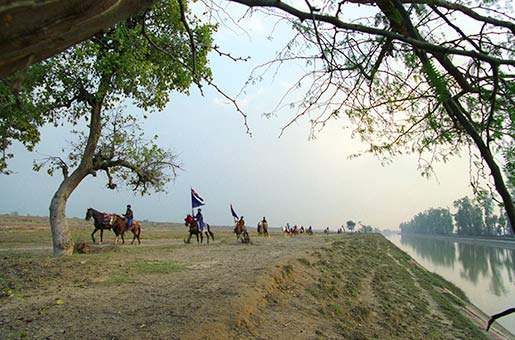 Environmental issues have taken a backseat for way too long. Even under this administration – which promised to create jobs through new and clean energy initiatives, and rejoin the international community to reduce worldwide carbon emissions – environmental issues have taken a backseat to health care overhaul and reviving our frail economy.
Environmental issues have taken a backseat for way too long. Even under this administration – which promised to create jobs through new and clean energy initiatives, and rejoin the international community to reduce worldwide carbon emissions – environmental issues have taken a backseat to health care overhaul and reviving our frail economy.
Crisis
We should be especially concerned because the consequences of misusing resources are all too clear in the near-crisis state that Punjab’s ecology is currently in. Those who still have relatives in Punjab know that this past summer, electricity outages were a daily occurrence and lasted 8 hours at a time – the worst in many years. These shortages in electricity occur because the government subsidizes electricity for farmers so that it’s free or nearly so and they can pump water for irrigation to their heart’s content. However, this leads to electricity shortages, overuse of waterpumps, and water wastage. [Forbes-India]
An article in Forbes-India asked yesterday, “Is India running out of water?” For Punjab, the answer is yes.
And Punjab, as the breadbasket of the most populous nation in the world, may be an indicator of other similarly situated agricultural communities.
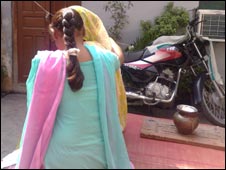 One of our goals on The Langar Hall is to raise awareness about issues affecting our community around the globe. Whether or not we identify or relate to these specific issues may not be as important as much as the acknowledgement that these issues do occur and that individuals and families and even children are affected. We hope that by raising awareness we can begin, as a community, to stand up against injustice in all its forms.
One of our goals on The Langar Hall is to raise awareness about issues affecting our community around the globe. Whether or not we identify or relate to these specific issues may not be as important as much as the acknowledgement that these issues do occur and that individuals and families and even children are affected. We hope that by raising awareness we can begin, as a community, to stand up against injustice in all its forms.
A recent article from the BBC reports that, according to campaigners in Punjab, British Asians are hiring contract killers to carry out up to 100 murders in India each year. One of the most well known cases is that of Surjit Athwal, a British Sikh woman who disappeared in Punjab in 1998. Eventually it was revealed that she had been murdered in a so-called honor killing after her in-laws discovered that she planned to divorce her husband. They had hired criminals in India to kill her. She was strangled and her body dumped in a river. Her brother, Jagdeesh Singh, now campaigns for other victims’ families.
“I think Surjit’s case exposed for the first time in this country overseas outsourced killings. How the Punjabi community, settled in Britain, send their females back to the land of origin, in the full knowledge that they can have them murdered easily, swiftly and efficiently.” [link]
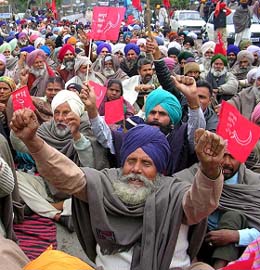 While I do value the role films play in telling stories, I wonder if at times it can do more harm than good. I recently heard about a new bollywood movie called Kisaan and had the opportunity to watch it last night. I had been told the movie was about farmer suicides in punjab and while i was aware it was a bollywood production, I definitely made time to watch it as it is such an important issue.
While I do value the role films play in telling stories, I wonder if at times it can do more harm than good. I recently heard about a new bollywood movie called Kisaan and had the opportunity to watch it last night. I had been told the movie was about farmer suicides in punjab and while i was aware it was a bollywood production, I definitely made time to watch it as it is such an important issue.
The movie touched upon issues such as the role illiteracy and dowry play in the lives of farmers – the reality of poverty overpowered by the hope of prosperity. These are important issues and should be discussed. Films are an important tool to utilize in order to raise awareness about such issues.
Suffice it to say, Kisaan is a bollywood production and is distracted by it’s commitment to bollywood requirements. I can’t say i wasn’t disappointed – this is such an important issue which needs to be explored. While i commend the director for attempting to raise the issue, i do question if this genre of film was the best vehicle for it. The issue was so entangled in the film, mixed in with songs and awkward jokes, that i can’t imagine how serious the issue will be taken.
Sotheby’s is having an auction today in New York of South Asian Modern and Contemporary Art including Miniature  Paintings.
Paintings.
Sotheby’s September 2009 auction of South Asian Art features a carefully-curated offering of works by leading modern and contemporary Indian artists, accompanied by an eclectic group of miniature paintings from the Rajput and Punjab Hills courts of northern India, as well as a selection of cutting-edge contemporary art from Pakistan. [Sotheby’s]
Of interest is a 1912 large portrait (approximately 5’x3′) of Guru Gobind Singh Ji estimated at $50,000-$70,000, as well as a miniature of all the Sikh Gurus with Guru Nanak Ji at the center, and a miniature of Maharaja Ranjit Singh on his stallion with weapons, accompanied by foot soldiers.
This large portrait of Guru Gobind Singh Ji, according to a Times of India article, is part of a series of four closely-related paintings depicting Guru Gobind Singh. Apparently each portrait was the inspiration for the next. It’s unclear where in the series this painting belongs or who the painter was, but the last painting in the series is currently on display at Hazur Sahib in Maharashtra and was created by Hari Singh.
Which leads to questions- if the last in the series is at the Hazur Sahib and this is at Sotheby’s, where are the other two? What path have these pieces taken? The works in this collection were probably passed down from one legitimate private owner to another. Perhaps they were commissioned by British officers. I have no evidence of anything otherwise.
But in general, the plunder from wars and violence often ends up on sale somewhere far from its source. The art and artifacts that were lost in Operation Bluestar weren’t inventoried. We don’t even have a way of identifying lost or stolen art in order to make a claim that it rightfully belongs to the community. Perhaps a budding art historian will be interested in a research project… attempting to document artwork remembered as being held at the Darbar Sahib or other sites of looting so that if it shows up on sale, we’ll be able to recover it.
According to a Deputy Director of Sotheby’s, the collector base for miniatures is largely made up of European, British and American collectors. It includes only a small group of NRIs. [TOI] Glad to see that we’re keeping our heritage intact for future generations! 😉
In the Faridkot centre… Harmanbir Kaur, 15, was rocking gently backwards and forwards. When her test results came back, they showed she had 10 times the safe limit of uranium in her body. Her brother, Naunihal Singh, six, has double the safe level. [link]
An article in The Observer discusses the link between the dramatic rise in birth defects in Punjab and pollution from coal-fired power stations. Many of the children are being treated in Faridkot and at the Baba Farid centers for special children in Bathinda, where there are two coal-fired thermal plants. Staff at these clinics had noticed an increase in the incidence of severely handicapped children who were born with hydroencephaly, microencephaly, cerebral palsy, Down’s syndrome and other complications. They suspected environmental poisoning.
The healthcare workers rightfully voiced their concerns about this and wondered, if some children were being treated, how many more were being affected? As with governments’ other dirty little secrets, staff at the clinics were visited and threatened if they spoke out. In addition, a visiting South African toxicologist arranged for tests to be carried out and found that the children had massive levels of uranium in their bodies, in one case more than 60 times the maximum safe limit. The scientist was later warned by the authorities that she may not be allowed back into the country.
On your next trip to India, how will you travel? Train, car, metro? How about in a solar-electric powered cycle rickshaw? Because now you can. 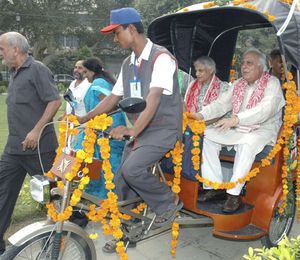
The Council of Scientific and Industrial Research, a government body, made a motor powered by a solar powered battery to decrease the effort required to pedal a cycle rickshaw. They call it a Solekshaw. It originally unveiled last year and has been testing in Delhi. [link] The Solekshaw can either be pedaled like a normal rickshaw or run on the solar powered battery for 30-42 miles before it needs to be recharged. Used batteries are recharged and replaced for a small fee at solar-powered stations. [Discovery]
Improvements on the original model are set to debut next year “with better aesthetics, ergonomics, speed and recumbent driving position.” [link]
The Solekshaw is made to carry 2 passengers (or 200 kg) and maxes out at 15 mph, which sounds normal for a cycle rickshaw (though I’m definitely not the best at gauging speed or weight). [link]
Coblogged by Camille and Reema
This week is Energy and Environment week. The environment has been front page news for a while now and one Sikh group is getting involved. 
Recently, SCORE launched a new initiative called EcoSikh, a project driven towards promoting environmentalism and environmental stewardship particularly in Punjab, but in the Sikh community at large. EcoSikh is the Sikh contribution to a larger project between the UNDP and the Alliance for Religions and Conservation (ARC, a UK-based NGO). UNDP and ARC are funding many religious communities to develop plans and ideas to integrate environmental consciousness into their members’ communities and personal behavior.
The program plans to work through 5 areas it has identified as: assets (using existing skills, time, resources for environmental projects), media/advocacy, eco-twinning (developing relationships of mutual benefit between various Sikh communities by sharing environmental ideas), celebration, and education. Each of the 5 program areas has been rooted in Sikh theology as a reminder of the historic import and connection with the environment in the Guru’s bani. A draft of the plan can be found here.
Punjab has been divided numerous times. Both during and after partition. Anita Rau Badami eloquently writes, “First it was Partition and half our land disappeared. Now our own leaders are chopping it up like a piece of meat”. The Punjabi language was one thing we hoped would cross borders despite all the “chopping”. Ultimately, it was the language of the Punjabi soul regardless of how political borders were drawn.
However, the Punjabi language is being lost. It has been granted “second language status” under the Official Language Act. Although extremely disappointing that Punjabi is given a 2nd status-one walks away thinking at least it still has some official status. However, Punjabis’ actions are speaking louder than our words when Punjabi is virtually not being taught in schools or used in official administrative work in Chandigarh. This abandonment is occurring despite the availability of financial assistance from the Central Government government to hire Punjabi language teachers. This financial assistance is supposed to cover the entire financial costs of language teachers’ appointments and salaries.
Prabhjot Singh writes for “The Tribune” that the Human Resource Development Minister Kapil Sibal (a Punjabi himself) stated:
None of the northern states other than Himachal Pradesh had applied for financial assistance for the appointment of Punjabi teachers during the past three years. Only Himachal Pradesh had obtained a grant in October 2007 for the appointment of 100 Punjabi teachers.
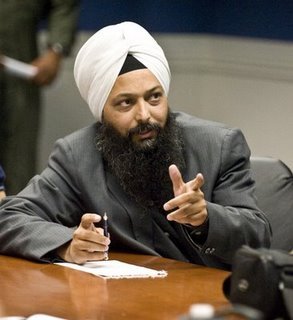 In a previous blog, I wrote about Jarnail Singh Journalist – Sikh Folk Hero. I also mentioned about his action as an act of rebellion that needs the support and institutions to become a revolution. In this post, he, himself, needs support.
In a previous blog, I wrote about Jarnail Singh Journalist – Sikh Folk Hero. I also mentioned about his action as an act of rebellion that needs the support and institutions to become a revolution. In this post, he, himself, needs support.
Unfortunately this week, as he flung his shoe demanding justice, he, himself, was victimized as he was terminated from the Hindi news daily Dainak Jagran, after more than a decade of service.
“As a journalist, I regret what I have done. It was not proper for a journalist to act in that manner. I was emotionally overtaken and exasperated, just like so many Sikhs are,” he said today.
“But I thought the chapter was closed because of the way the home minister had reacted and had accepted that not enough people (who were behind the killing of Sikhs in 1984) had been punished,” Jarnail said.
“Now I feel that I am being victimised, punished for raising my voice against the injustice of 1984 and the CBI’s and the government’s unwillingness to prosecute those who were responsible for it”, Jarnail said. He said he was even more resolute now.[link]
Oh India. You can’t hide the skeletons in your closet forever.
It appears that the US Commission on International Religious Freedom was on its way to India this week. (The USCIRF is a federal group that works to promote freedom of thought, conscience and religion; protect people from abuses like detention, killing and torture; and challenge religious intolerance and repression throughout the world.) Well, they were scheduled to go, had their tickets ready and their bags packed. But India’s administration decided that they weren’t welcome in India.
It’s really quite ironic. The Congress party’s recent Parliamentary win over the BJP has been seen as an explicit rejection of the religious intolerance that the BJP represents (though it may have had more to do with support for Congress’ economic policies). Yet it is the Congress party administration that has refused USCIRF entry. Maybe the Congress party’s sound defeat of the BJP has swelled the Congress Party’s confidence a little too much.
New Delhi knew that the USCIRF team was scheduled to leave on June 12, but the visas just didn’t get stamped in time. Was it just a rare and regrettable oversight? [After all, with so many tourists flooding the country, a few visas could fall through the cracks right? (HA!)]
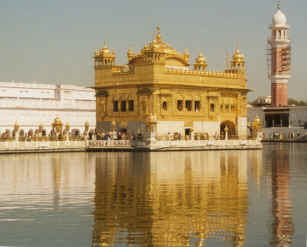 For some Sikhs in Punjab, apparently two Harmandar Sahibs. Or at least that’s the argument between the SGPC and a group of Sikhs. The SGPC argues that a group of Sikhs are building a replica of Harmandar Sahib, and that they stridently oppose any “imitation” gurdwaras (my phrase, not theirs).
For some Sikhs in Punjab, apparently two Harmandar Sahibs. Or at least that’s the argument between the SGPC and a group of Sikhs. The SGPC argues that a group of Sikhs are building a replica of Harmandar Sahib, and that they stridently oppose any “imitation” gurdwaras (my phrase, not theirs).
The Sikhs, who are definitely building a gurdwara (but whether or not it is intended to be a replica is contested), argue that the SGPC is trying to stir up trouble and adopting wedge politics tactics to scramble for power.
At first I read this story and thought to myself, “Wow, that is wacky.” But the longer I’ve reflected on it, the more I have to ask — REALLY???
 This past weekend Wal-Mart opened its first* Indian-based store in Amritsar, spreading its global brand to one of the fastest-growing markets in the world. As part of a larger strategy to develop a presence in India, this is the first of fifteen new stores that will open over the next few years. [source]
This past weekend Wal-Mart opened its first* Indian-based store in Amritsar, spreading its global brand to one of the fastest-growing markets in the world. As part of a larger strategy to develop a presence in India, this is the first of fifteen new stores that will open over the next few years. [source]
However, instead of targetting low-income consumers and discount shoppers, Wal-Mart India’s business model focuses on wholesales to small shop stand owners. This decision seems largely based in regional market dynamics. Wal-Mart does not think it can crowd out a market share against small dhabas and the like, and instead opts for wholesaling:
Mr. Singh and the more than 10 million other tiny retailers in India are Wal-Mart’s greatest challenge and greatest opportunity. If it can win them over, they are likely to become its biggest customers. Anger them and they could use their political power to block expansion.
Wal-Mart entered with nary a whisper or protest, despite years of vocal opposition to big-box stores in the past. The WSJ cites the slowing economy, but I wonder to what extent choosing Amritsar, as opposed to metro Mumbai or Delhi, indicates Wal-Mart’s desire to build a presence in transitional, recessionary regional economies.
In remembrance of the 25th anniversary of the Darbar Sahib attack, I’m re-posting a piece I had written for sikhchic.com‘s “1984 & I” series:
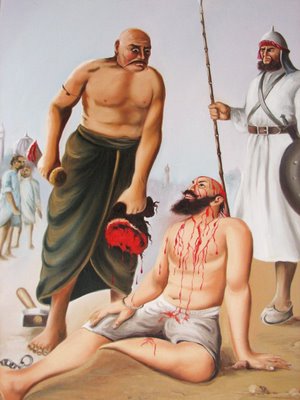
This Is Who We Are
Years ago, I was giving a local church group a tour of our Gurdwara. While I was showing them around the langar hall and explaining the history and significance of langar, I noticed that I was losing my audience. It took me a second to figure it out, but it appeared they were fixated on one of the images on the wall. It was the painting we’ve all seen of Bhai TaruSingh being scalped and blood running down his body. I’m not sure what shocked them more – the graphic painting itself, or the five-year-old boy sitting beneath it, quietly eating his meal.
For just a second, I put myself in their shoes. I looked around the room and saw pictures of Sikh martyrs from the 18th century – a man being boiled alive, a person being sawed in half, two little boys being bricked alive, and an old man with his fingers getting chopped off. And I thought to myself…is this really necessary, the depiction of these scenes in these surroundings?
I started to wonder: are these images really what we want to convey to our visitors? Shouldn’t we find something that depicts universality and love for humanity? Especially after 9/11, shouldn’t we be displaying a softer image of Sikhs? After all, this dining area is a place for us to share a common meal, and little children play down here, for God’s sake! Is this really appropriate?
But then it dawned on me …
This is who we are.
This week, Peter Bance published “Sovereign, Squire and Rebel: Maharajah Duleep Singh and the Heirs of a Lost Kingdom.” It includes some little known and interesting information on Rani Jindan- the youngest of Maharaja 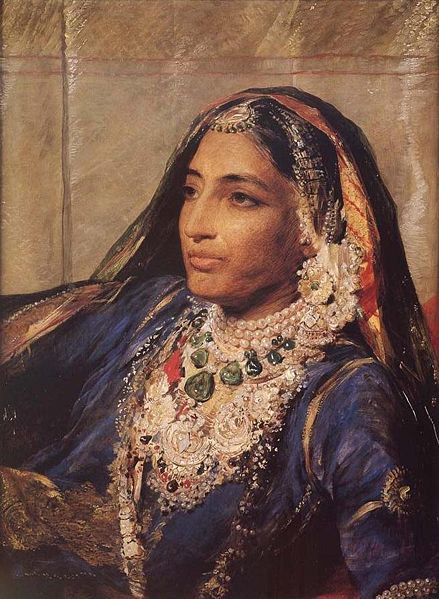 Ranjit Singh’s wives. While the tale of her son, Duleep Singh, has been well documented, less has been known about Rani Jindan.
Ranjit Singh’s wives. While the tale of her son, Duleep Singh, has been well documented, less has been known about Rani Jindan.
While researching a tome on the Duleep Singh family, which lived in exile on a sprawling country estate near Thetford, Norfolk, Mr Bance stumbled upon the gravestone of Jind Kaur in the catacombs of the Kensal Green Dissenters’ Chapel. Historians had assumed that the Maharani’s cremation occurred in India but here was a simple white marble tombstone in London with her name on it. [link]
So who was Rani Jind Kaur? Some things were previously known- that after the death of her husband, she became the Regent (acting head of state because the ruler is a minor) for her son, Duleep Singh.
To say that Jind Kaur was a thorn in the side of the East India Company would be an understatement. She was born into humble origins, the daughter of the Royal Kennel Keeper at the Sikh court in Lahore, but she was ravishingly beautiful and soon caught the attention of the Punjab’s greatest ruler, the one-eyed Ranjit Singh.
Having kept the British at bay for decades, Ranjit’s empire began to crumble with his death in 1839. Following a series of bloody succession battles, Jind emerged as regent for Duleep who was less than a year old when his father died. [link]
Rani Jindan was instrumental in organizing Sikh resistance to the British in the First and Second Anglo-Sikh wars.
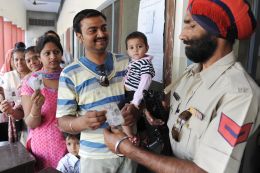 The election results in India seem to be in. The Congress Party has increased its power in the center and even some of the commenters here in The Langar Hall have been jubilant.
The election results in India seem to be in. The Congress Party has increased its power in the center and even some of the commenters here in The Langar Hall have been jubilant.
While the Indian elections have received brief commentary, here and there in The Langar Hall, the results call out for some analysis towards a Sikh perspective.
Overwhelming have been the shouts of “Singh is King” as it seems that Manmohan Singh will continue to keep the Prime Minister position, at least if his victory-speech is any indication, until his political overseers – the Gandhi family – are ready to replace the kursi-warmer with Rahul Gandhi. Others in The Langar Hall have already written critical pieces of this so-called Great Sikh Hype.
News media have rightly commented on the Congress Party’s sweeping electoral victories in Delhi on the party’s dumping of the mass-murderers Jagdish Tytler and Sajjan Kumar (albeit it seems more political maneuvering – with one of the positions filled by Sajjan Kumar’s brother, than any true remorse) and the projection of Manmohan Singh as a way to draw Sikh votes in Delhi away from BJP candidates. As a strategic community, Sikhs in no way should they tether their votes to a single party.
Breakthrough is an innovative, international human rights organization using the power of popular culture, media, leadership development and community education to transform public attitudes and advance equality, justice, and dignity. Through initiatives in India and the United States, Breakthrough addresses critical global issues including violence against women, sexuality and HIV/AIDS, racial justice, and immigrant rights. [link]
A friend directed me to this video which reflects the use of media to educate society about human rights issue. The video I have included below is one of many produced by Breakthrough, an organization whose aim is to create a culture of human rights. “Breakthrough’s multi-media campaign, “Is This Justice?” aims to bring public attention to the stigma and discrimination faced by women living with HIV/AIDS-most of whom have been infected by their husbands or male partners.” I found this piece, titled A man looks at me but I’m the one who is being punished, to be quite powerful. Is this justice?

